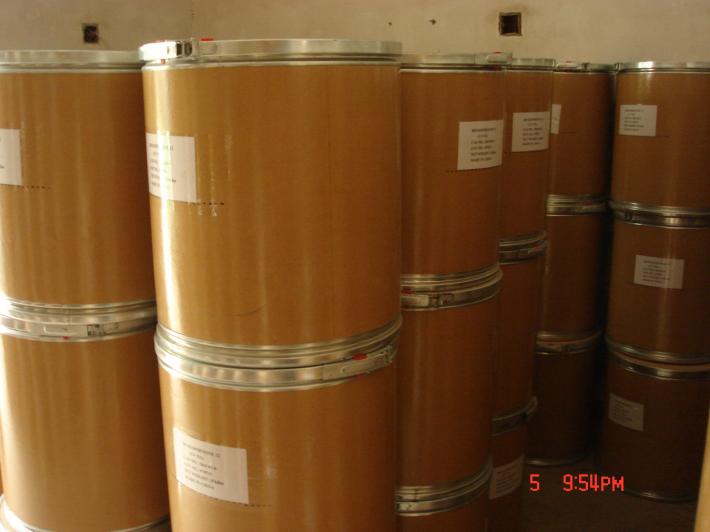富马酸是一种羧酸。如果存在碱,则羧酸会释放氢离子。它们以这种方式与所有碱(有机(例如胺)和无机碱)反应。它们与碱的反应,称为“中和”,伴随着大量热量的释放。酸和碱之间的中和产生水加盐。具有六个或更少碳原子的羧酸可自由或中度溶于水;碳原子数超过6的化合物微溶于水。水溶性羧酸在水中解离一定程度以产生氢离子。因此,羧酸溶液的pH小于7.0。许多不溶性羧酸与含有化学碱的水溶液迅速反应,并随着中和生成可溶盐而溶解。
Fumaric acid is a carboxylic acid. If a base is present, the carboxylic acid releases hydrogen ions. In this way they react with all bases (organic (e.g., amines) and inorganic bases. Their reaction with alkali, called neutralization, is accompanied by the release of a large amount of heat. Neutralization between acid and alkali produces water and salt. Carboxylic acids with six or fewer carbon atoms are free or moderately soluble in water; compounds with more than six carbon atoms are slightly soluble in water. Water soluble carboxylic acids dissociate to a certain extent in water to produce hydrogen ions. Therefore, the pH value of carboxylic acid solution is less than 7.0. Many insoluble carboxylic acids react rapidly with aqueous solutions containing chemical bases, and dissolve with neutralization to form soluble salts.
水溶液中的羧酸和液体或熔融羧酸可与活性金属反应形成气态氢和金属盐。这样的反应原则上也对固体羧酸发生,但是如果固体酸保持干燥,则反应会缓慢。甚“不溶”羧酸也可能从空气中吸收足够的水,并在其中充分溶解,从而腐蚀或溶解铁,钢和铝的零件和容器。羧酸与其他酸一样,与氰化物盐反应生成气态氰化氢。对于干燥的固体羧酸,反应较慢。不溶性羧酸与氰化物溶液反应,导致释放出气态氰化氢。
Carboxylic acids in aqueous solution and liquid or molten carboxylic acids can react with active metals to form gaseous hydrogen and metal salts. In principle, this reaction also occurs for solid carboxylic acids, but if the solid acids are kept dry, the reaction will be slow. Even "insoluble" carboxylic acids may absorb enough water from the air and dissolve them sufficiently to corrode or dissolve iron, steel and aluminum parts and containers. Carboxylic acid, like other acids, reacts with cyanide salts to form gaseous hydrogen cyanide. For dry solid carboxylic acids, the reaction is slow. The insoluble carboxylic acid reacts with cyanide solution, resulting in the release of gaseous hydrogen cyanide.
羧酸与重氮化合物,二硫代氨基甲酸酯,异氰酸酯,硫醇,氮化物和硫化物的反应会产生易燃或有毒气体和热量。羧酸,尤其是水溶液中的羧酸,还会与亚硫酸盐,亚硝酸盐,硫代硫酸盐(生成H2S和SO3),连二亚硫酸盐(SO2)反应,生成易燃或有毒气体和热量。它们与碳酸盐和碳酸氢盐的反应生成无害气体(二氧化碳),但仍会发热。
The reaction of carboxylic acids with diazo compounds, dithiocarbamates, isocyanates, mercaptans, nitrides and sulfides can produce flammable or toxic gases and heat. Carboxylic acids, especially carboxylic acids in aqueous solutions, react with sulfites, nitrites, thiosulphates (to form H2S and SO3), and dithionite (SO2) to produce flammable or toxic gases and heat. They react with carbonates and bicarbonates to produce a harmless gas (carbon dioxide), but still generate heat.
像其他有机化合物一样,羧酸可被强氧化剂氧化,并被强还原剂还原。这些反应会产生热量。各种各样的产品都是可能的。像其他酸一样 羧酸可引发聚合反应;像其他酸一样,它们经常催化(增加反应速率)。在446°(开放容器)下发生部分碳化和马来酸酐的形成。
Like other organic compounds, carboxylic acids can be oxidized by strong oxidants and reduced by strong reducing agents. These reactions produce heat. All kinds of products are possible. Like other acids, carboxylic acids initiate polymerization; like other acids, they often catalyze. Partial carbonization and maleic anhydride formation occurred at 446 ° in an open container.




